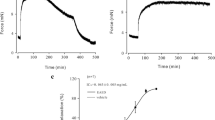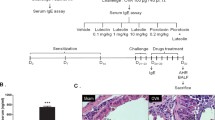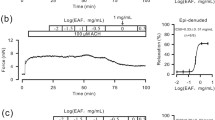Abstract
Asthma is an inflammatory disease characterized by airway hyperresponsiveness, airway remodeling, and airway inflammation. In recent years, the prevalence of asthma has been increasing steadily and the pathogenesis of asthma varies from person to person. Due to poor compliance or resistance, existing drugs cannot achieve the desired therapeutic effect. Therefore, developing or screening asthma therapeutic drugs with high curative effects, low toxicity, and strong specificity is very urgent. Duloxetine HCl (DUX) is a selective serotonin and norepinephrine reuptake inhibitor, and it was mainly used to treat depression, osteoarthritis, and neuropathic pain. It was also reported that DUX has potential anti-infection, anti-inflammation, analgesic, antioxidative, and other pharmacological effects. However, whether DUX has some effects on asthma remains unknown. In order to investigate it, a series of ex vivo and in vivo experiments, including biological tension tests, patch clamp, histopathological analysis, lung function detection, oxidative stress enzyme activity detection, and molecular biology experiments, were designed in this study. We found that DUX can not only relax high potassium or ACh precontracted tracheal smooth muscle by regulating L-type voltage-dependent Ca2+ channel (L-VDCC) and nonselective cation channel (NSCC) ion channels but also alleviate asthma symptoms through anti-inflammatory and antioxidative response regulated by PI3K/AKT/mTOR and Nrf2/HO-1 signaling pathways. Our data suggests that DUX is expected to become a potential new drug for relieving or treating asthma.












Similar content being viewed by others
Data Availability
All data generated and analyzed in this study are available upon reasonable request from the corresponding author.
Abbreviations
- ACh:
-
Acetylcholine chloride
- Al(OH)3 :
-
Aluminum hydroxide
- BALF:
-
Bronchoalveolar lavage fluids
- BSA:
-
Bovine serum albumin
- CAT:
-
Catalase
- DEX:
-
Dexamethasone
- DMSO:
-
Dimethyl sulfoxide
- DTT:
-
Dithiothreitol
- DUX:
-
Duloxetine HCl
- Ers:
-
Respiratory system elasticity
- HBSS:
-
Hanks’ balanced salt solution
- H&E:
-
Hematoxylin and eosin
- HO-1:
-
Heme oxygen 1
- IC50 :
-
Half-maximal inhibitory concentration
- IC75 :
-
Seventy-five percent of maximal inhibitory concentration
- IL-4:
-
Interleukin 4
- IL-5:
-
Interleukin 5
- IL-13:
-
Interleukin 13
- IG:
-
Intragastrical administration
- IN:
-
Intranasally
- IP:
-
Intraperitoneal injections
- Keap1:
-
Kelch-like ECH-associated protein 1
- L-VDCC:
-
L-type voltage-dependent Ca2+ channel
- MAPK:
-
Mitogen-activated protein kinase
- MDA:
-
Malondialdehyde
- mTOR:
-
Mammalian target of rapamycin
- mTRs:
-
Mouse tracheal rings
- NA:
-
Niflumic acid
- Nrf2:
-
Nuclear factor-erythroid 2-related factor 2
- NSCCs:
-
Nonselective cation channels
- OVA:
-
Ovalbumin
- PAS:
-
Periodic acid-Schiff
- PFA:
-
Paraformaldehyde
- PI3K:
-
Phosphatidylinositol-3-kinase
- PSS:
-
Physiological salts solution
- Pyr3:
-
Pyrazole 3
- Rrs:
-
Respiratory system resistance
- SD:
-
Standard deviation
- SNRI:
-
Serotonin and norepinephrine reuptake inhibitors
- SPF:
-
Specific pathogen-free
- SOD:
-
Superoxide dismutase
- TEA:
-
Tetraethylammonium chloride
- TBST:
-
Tris-Buffered Saline Tween-20
- TNF-α:
-
Tumor necrosis factor alpha
- TRPC3:
-
Transient receptor potential channel 3
References
To, T., S. Stanojevic, G. Moores, A.S. Gershon, E.D. Bateman, and A.A. Cruz. 2012. Boulet L-PJBph: Global asthma prevalence in adults: Findings from the cross-sectional world health survey. 12: 1–8.
Mortimer, K., M. Lesosky, L. García-Marcos, M.I. Asher, N. Pearce, E. Ellwood, K. Bissell, A. El Sony, P. Ellwood, and G.B.J.E.R.J. Marks. 2022. The burden of asthma, hay fever and eczema in adults in 17 countries: GAN Phase I study. 60.
Gauvreau, G.M., and A.I. El-Gammal. 2015. O’Byrne PMJERJ: Allergen-induced airway responses. 46: 819–831.
Rachelefsky, G.S., and Y. Liao. 2007. Faruqi RJAoA. Asthma, Immunology: Impact of inhaled corticosteroid-induced oropharyngeal adverse events: Results from a meta-analysis. 98: 225–238.
Ercan, H., E. Birben, E.A. Dizdar, O. Keskin, C. Karaaslan, O.U. Soyer, R. Dut, C. Sackesen, and T. Besler. 2006. Kalayci OJJoA. Immunology C: Oxidative stress and genetic and epidemiologic determinants of oxidant injury in childhood asthma. 118: 1097–1104.
Kirkham, P., and I.J.P. Rahman. 2006. Therapeutics: Oxidative stress in asthma and COPD: antioxidants as a therapeutic strategy. 111: 476–494.
Erzurum, S.C. 2016. JAotATS: New insights in oxidant biology in asthma. 13: S35–S39.
Comhair, S.A., and S.C.J.A. Erzurum. 2010. Signaling r: Redox control of asthma: molecular mechanisms and therapeutic opportunities. 12: 93–124.
Yang, L.-L., M.-S. Huang, C.-C. Huang, T.-H. Wang, M.-C. Lin, C.-C. Wu, C.-C. Wang, and S.-H. Lu. 2011. Yuan T-Y. Liao Y-HJIaoa, immunology: The association between adult asthma and superoxide dismutase and catalase gene activity. 156: 373–380.
Zhu, Y., C. Wang, J. Luo, S. Hua, D. Li, L. Peng, H. Liu, and L.J.F. Song. 2021. Function: The protective role of Zingerone in a murine asthma model via activation of the AMPK/Nrf2/HO-1 pathway. 12: 3120–3131.
Lim, J.-O., K.H. Song, I.S. Lee, S.-J. Lee, W.-I. Kim, S-W. Pak, I-S. Shin, and T.J.A Kim. 2021. Cimicifugae rhizoma extract attenuates oxidative stress and airway inflammation via the upregulation of Nrf2/HO-1/NQO1 and downregulation of NF-κB phosphorylation in ovalbumin-induced asthma. 10: 1626.
Osani, M.C. 2019. Bannuru RRJTKjoim: Efficacy and safety of duloxetine in osteoarthritis: A systematic review and meta-analysis. 34: 966.
Jones, C.K., and S.C. Peters. 2007. Peters SC. Shannon HEJEJoP: Synergistic interactions between the dual serotonergic, noradrenergic reuptake inhibitor duloxetine and the non-steroidal anti-inflammatory drug ibuprofen in inflammatory pain in rodents. 11: 208–215.
Martín-Hernández, D., Á.G. Bris, K.S. MacDowell, B. García-Bueno, J.L. Madrigal, J.C. Leza, and J.R.J.N. Caso. 2016. Modulation of the antioxidant nuclear factor (erythroid 2-derived)-like 2 pathway by antidepressants in rats. 103: 79–91.
Martínez, F.C.P., and R.V. Navarrete. 2006. Reparaz CCJAEdU: Comparative effects of clomipramine and duloxetine on detrusor and striated sphincter function in male and female rabbits. 59: 839–848.
Engel, D.F., J. de Oliveira, V. Lieberknecht, A.L.S. Rodrigues, A.F. de Bem, and N.H.J.N.r. Gabilan. 2018. Duloxetine protects human neuroblastoma cells from oxidative stress-induced cell death through Akt/Nrf-2/HO-1 pathway. 43: 387–396.
Jorgensen, A., K. Köhler-Forsberg, T. Henriksen, A. Weimann, I. Brandslund, C. Ellervik, H.E. Poulsen, G.M. Knudsen, and V.G. Frokjaer. 2022. Jorgensen MBJTp: Systemic DNA and RNA damage from oxidation after serotonergic treatment of unipolar depression. 12: 204.
Meng, J., Q. Zhang, C. Yang, L. Xiao, Z. Xue, and J.J.F.i.P. Zhu. 2019. Duloxetine, a balanced serotonin-norepinephrine reuptake inhibitor, improves painful chemotherapy-induced peripheral neuropathy by inhibiting activation of p38 MAPK and NF-κB. 10: 365.
Yang, N., and Y.J.O.M Shang. 2022. Longevity C: Ferrostatin-1 and 3-methyladenine ameliorate ferroptosis in ova-induced asthma model and in il-13-challenged beas-2b cells.
Zhang, T., X.-J. Luo, W.-B. Sai, M.-F. Yu, W.-E. Li, Y.-F. Ma, W. Chen, K. Zhai, and G. Qin. 2014. Guo DJPo: Non-selective cation channels mediate chloroquine-induced relaxation in precontracted mouse airway smooth muscle. 9: e101578.
Jiang, Q.-J., W. Chen, H. Dan, L. Tan, H. Zhu, G. Yang, J. Shen, Y.-B. Peng, P. Zhao, and Xue L. 2016. JE-BC. Medicine A: Cortex phellodendri extract relaxes airway smooth muscle. 8703239
Yang, X., M.-F. Yu, J. Lei, Y.-B. Peng, P. Zhao, L. Xue, W. Chen, L.-Q. Ma, Q.-H. Liu, and J.J.P.M. Shen. 2018. Nuciferine relaxes tracheal rings via the blockade of VDLCC and NSCC channels. 84: 83–90.
Kalidhindi, R.S.R., N.S. Ambhore, P. Balraj, T. Schmidt, and M.N. Khan. 2021. Sathish VJAJoP-LC. Physiology M: Androgen receptor activation alleviates airway hyperresponsiveness, inflammation, and remodeling in a murine model of asthma. 320: L803–L818.
Dai, R., M. Niu, N. Wang, and Y.J.E.T. Wang. 2021. Syringin alleviates ovalbumin-induced lung inflammation in BALB/c mice asthma model via NF-κB signaling pathway. 36: 433–444.
Wang, H., X. Zhong, W.-Y. Shi, and B. Guo. 2011. JAJoB: Study of malondialdehyde (MDA) content, superoxide dismutase (SOD) and glutathione peroxidase (GSH-Px) activities in chickens infected with avian infectious bronchitis virus. 10: 9213–9217.
Jones, C.K., and S.C. Peters. 2005. Shannon HEJJoP. Therapeutics E: Efficacy of duloxetine, a potent and balanced serotonergic and noradrenergic reuptake inhibitor, in inflammatory and acute pain models in rodents. 312: 726–732.
Wang, P., W. Zhao, J. Sun, T. Tao, X. Chen, Y.-Y. Zheng, C.-H. Zhang, Z. Chen, Y.-Q. Gao, F. She, and Y.Q. Li. 2018. Immunology C: Inflammatory mediators mediate airway smooth muscle contraction through a G protein-coupled receptor–transmembrane protein 16A–voltage-dependent Ca2+ channel axis and contribute to bronchial hyperresponsiveness in asthma. 141: 1259–1268. e1211.
Yang, Y., W. Chen, N. Wen, and C. Cai. 2019. Liu Q-h. Shen JJLs: Benidipine, an anti-hypertensive drug, relaxes mouse airway smooth muscle. 227: 74–81.
Lu, M., X.X. Fang, D.D. Shi, R. Liu, Y. Ding, Q.F. Zhang, H.Q. Wang, J.M. Tang, and X.J. He. 2020. A selective TRPC3 inhibitor Pyr3 attenuates myocardial ischemia/reperfusion injury in mice. Current Medical Science 40: 1107–1113.
Lawrence, K.M., R.C. Jones, T.R. Jackson, R.L. Baylie, B. Abbott, B. Bruhn-Olszewska, T.N. Board, I.C. Locke, S.M. Richardson, and P.A. Townsend. 2017. Chondroprotection by urocortin involves blockade of the mechanosensitive ion channel Piezo1. Science and Reports 7: 5147.
Keeney, G.E., M.P. Gray, A.K. Morrison, M.N. Levas, E.A. Kessler, G.D. Hill, M.H. Gorelick, and J.L. Jackson. 2014. Dexamethasone for acute asthma exacerbations in children: A meta-analysis. Pediatrics 133: 493–499.
Paniagua, N., R. Lopez, N. Muñoz, M. Tames, E. Mojica, E. Arana-Arri, S. Mintegi, and J. Benito. 2017. Randomized trial of dexamethasone versus prednisone for children with acute asthma exacerbations. Journal of Pediatrics 191: 190-196.e191.
Doymaz, S., Y.E. Ahmed, D. Francois, R. Pinto, R. Gist, M. Steinberg, and C. Giambruno. 2022. Methylprednisolone, dexamethasone or hydrocortisone for acute severe pediatric asthma: Does it matter? Journal of Asthma 59: 590–596.
Filep, J.G., B. Battistini, A. Fournier, and P. Sirois. 1993. JEjop: Relaxation by dexamethasone of isolated guinea-pig airways precontracted with endothelin-1. 240: 315–318.
Obejero-Paz, C.A., M. Lakshmanan, S.W. Jones, and A. Scarpa. 1993. JFl: Effects of dexamethasone on L‐type calcium currents in the A7r5 smooth muscle‐derived cell line. 333: 73–77.
Selli, C., and M. Tosun. 2016. JJop. biochemistry: Effects of cyclopiazonic acid and dexamethasone on serotonin-induced calcium responses in vascular smooth muscle cells. 72: 245–253.
Zaiss, M.M., A. Rapin, L. Lebon, L.K. Dubey, I. Mosconi, K. Sarter, A. Piersigilli, L. Menin, A.W. Walker, and J.J.I. Rougemont. 2015. The intestinal microbiota contributes to the ability of helminths to modulate allergic inflammation. 43: 998–1010.
McGee, H.S., and D.K. Agrawal. 2009. JAjor, medicine cc: Naturally occurring and inducible T-regulatory cells modulating immune response in allergic asthma. 180: 211–225.
Finkelman, F.D., S.P. Hogan, G.K.K. Hershey, and M.E. Rothenberg. 2010. Wills-Karp MJTJoI: Importance of cytokines in murine allergic airway disease and human asthma. 184: 1663–1674.
Zhang, L., M. Wang, X. Kang, P. Boontheung, N. Li, A.E. Nel, and J.A. Loo. 2009. JJopr: Oxidative stress and asthma: proteome analysis of chitinase-like proteins and FIZZ1 in lung tissue and bronchoalveolar lavage fluid. 8: 1631–1638.
Vyas, P., and D. Vohora. 2017. JCdt: Phosphoinositide-3-kinases as the novel therapeutic targets for the inflammatory diseases: current and future perspectives. 18: 1622–1640.
Saunders, R.M., M. Biddle, Y. Amrani, and C.E. Brightling. 2022. JFRB, Medicine: Stressed out-the role of oxidative stress in airway smooth muscle dysfunction in asthma and COPD. 185: 97–119
Fuller, R.W., and S.K. Hemrick-Luecke. 1994. Snoddy HDJJoP. Therapeutics E: Effects of duloxetine, an antidepressant drug candidate, on concentrations of monoamines and their metabolites in rats and mice. 269: 132–136.
Akpinar, A., Uğuz, A.C., and M. Nazıroğlu. 2014. JTJomb: Agomelatine and duloxetine synergistically modulates apoptotic pathway by inhibiting oxidative stress triggered intracellular calcium entry in neuronal PC12 cells: role of TRPM2 and voltage-gated calcium channels. 247: 451–459.
Dionisie, V., G.A. Filip, M.C. Manea, M. Manea, and S.J.I. Riga. 2021. The anti-inflammatory role of SSRI and SNRI in the treatment of depression: A review of human and rodent research studies. 29: 75–90.
Demirdaş, A., M. Nazıroğlu, and İ.S. Övey. 2017. JMn: Duloxetine reduces oxidative stress, apoptosis, and Ca 2+ entry through modulation of TRPM2 and TRPV1 channels in the hippocampus and dorsal root ganglion of rats. 54: 4683–4695.
Rodrigues-Amorim, D., and J.M. Olivares. 2020. Spuch C. Rivera-Baltanás TJFip: A systematic review of efficacy, safety, and tolerability of duloxetine. 11: 554899.
Hamid, Q. 2009. Tulic MJArop: Immunobiology of asthma. 71: 489–507.
Pera, T., and R.B. Penn. 2016. J.P. therapeutics: Bronchoprotection and bronchorelaxation in asthma: New targets, and new ways to target the old ones. 164: 82–96.
Hastie, A., C. Steele, C. Dunaway, W. Moore, B. Rector, E. Ampleford, H. Li, L. Denlinger, N. Jarjour, D.J.C. Meyers, and E. Allergy. 2018. Complex association patterns for inflammatory mediators in induced sputum from subjects with asthma. 48: 787–797.
Meyer, K.C. 2007. Bronchoalveolar lavage as a diagnostic tool. In Seminars in respiratory and critical care medicine. © Thieme Medical Publishers. 546–560.
Kidd, P. 2003. JAmr: Th1/Th2 balance: the hypothesis, its limitations, and implications for health and disease. 8: 223–246.
Lambrecht, B.N., H. Hammad, and J.V.J.I. Fahy. 2019. The cytokines of asthma. 50: 975–991.
Nguyen, T.H., S. Maltby, J.L. Simpson, F. Eyers, K.J. Baines, P.G. Gibson, P.S. Foster, and M. Yang. 2016. JTJoI: TNF-α and macrophages are critical for respiratory syncytial virus–induced exacerbations in a mouse model of allergic airways disease. 196: 3547–3558.
Fitzpatrick, A.M., Y. Park, L.A.S. Brown, and D.P. Jones. 2014. JJoA, Immunology C: Children with severe asthma have unique oxidative stress–associated metabolomic profiles. 133: 258–261. e258.
Sebag, S.C., O.M. Koval, J.D. Paschke, C.J. Winters, O.A. Jaffer, R. Dworski, F.S. Sutterwala, M.E. Anderson, and I.M. Grumbach. 2017. JJi: Mitochondrial CaMKII inhibition in airway epithelium protects against allergic asthma. 2(3): e88297.
Sabir, S., S. Ahmad, A. Hamid, M. Khan, M. Athayde, D. Santos, A. Boligon, and J.J.F.C. Rocha. 2012. Antioxidant and hepatoprotective activity of ethanolic extract of leaves of Solidago microglossa containing polyphenolic compounds. 131: 741–747.
Ito, K., Caramori, G., and I.M. Adcock. 2007. JJoP. Therapeutics E: Therapeutic potential of phosphatidylinositol 3-kinase inhibitors in inflammatory respiratory disease. 321: 1–8.
Ma, B., S.S. Athari, E. Mehrabi Nasab, and L. Zhao. 2021. JI: PI3K/AKT/mTOR and TLR4/MyD88/NF-κB signaling inhibitors attenuate pathological mechanisms of allergic asthma. 44: 1895–1907.
Ye, P., X.-L. Yang, X. Chen, and C. Shi. 2017. JII: Hyperoside attenuates OVA-induced allergic airway inflammation by activating Nrf2. 44: 168–173.
Liu, Y., F. Lu, L. Kang, Z. Wang, and Y. Wang. 2017. Pirfenidone attenuates bleomycin-induced pulmonary fibrosis in mice by regulating Nrf2/Bach1 equilibrium. BMC Pulmonary Medicine 17: 63.
Huang, Y., W. Li, Z.-Y. Su, and A.-N. Kong. 2015. TJTJonb: The complexity of the Nrf2 pathway: beyond the antioxidant response. 26: 1401–1413.
Acknowledgements
We appreciate all the colleagues who work in Institute for Medical Biology for their scientific and technical support.
Funding
This project was supported by the National Natural Science Foundation of China (Grant No. 31771274) to Jinhua Shen, the Fund for Key Laboratory Construction of Hubei Province (Grant No. 2018BFC360), and “The Fundamental Research Funds for the Central Universities,” South-Central Minzu University (Grant Number: CZQ22013).
Author information
Authors and Affiliations
Contributions
J.S. and L.X. conceived and designed the experiments. C.P., Y.Y., and W.C. performed the experiments. C.P. and W.W. analyzed the data and generated the figures. J.S. and L.X. wrote the manuscript.
Corresponding author
Ethics declarations
Ethics Approval and Consent to Participate
All the animal experiments were approved by and performed in accordance with the guidelines of the Animal Care and Ethics Committee of South-Central Minzu University (Wuhan, China).
Consent for Publication
Not applicable.
Competing Interests
The authors declare no competing interests.
Additional information
Publisher's Note
Springer Nature remains neutral with regard to jurisdictional claims in published maps and institutional affiliations.
Changsi Peng and Lu Xue contribute equally to this work
Supplementary Information
Below is the link to the electronic supplementary material.
Rights and permissions
Springer Nature or its licensor (e.g. a society or other partner) holds exclusive rights to this article under a publishing agreement with the author(s) or other rightsholder(s); author self-archiving of the accepted manuscript version of this article is solely governed by the terms of such publishing agreement and applicable law.
About this article
Cite this article
Peng, C., Xue, L., Yue, Y. et al. Duloxetine HCl Alleviates Asthma Symptoms by Regulating PI3K/AKT/mTOR and Nrf2/HO-1 Signaling Pathways. Inflammation 46, 2449–2469 (2023). https://doi.org/10.1007/s10753-023-01892-5
Received:
Revised:
Accepted:
Published:
Issue Date:
DOI: https://doi.org/10.1007/s10753-023-01892-5




